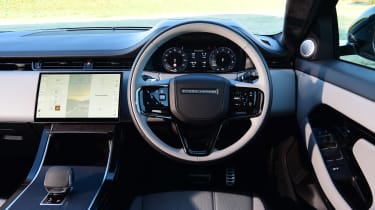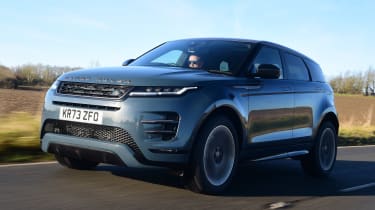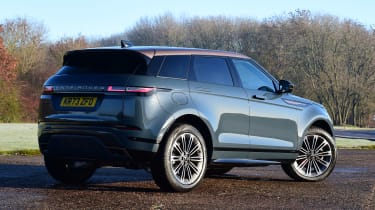New Range Rover Evoque 2024 review: premium plug-in hybrid is pricey!
The updated Evoque has been fitted with new tech and an impressive plug-in hybrid powertrain to keep it competitive, but this comes at quite a cost
4.0 out of 5
How we review carsPricefrom £40,080Find your Land Rover Range Rover EvoqueOffers from our trusted partners on this car and its predecessors…

As fitted to other models, the brand’s latest Pivi Pro operating system is superb. The menus are easy to navigate and it doesn’t feel like there too are many unnecessary steps to find key functions. It’s quick to respond too and the resolution is sharp, though we did notice the screen getting rather toasty. The new layout looks super-slick (not that the old set-up was dated) and the loss of the lower screen allows for extra storage and a smartphone charging pad. The centre console section was finished in a classy ‘Grey Ash’ veneer on our car, too.
More reviews
Car group tests
- Audi Q3 vs Range Rover Evoque vs Volvo XC40
- Range Rover Evoque vs Volvo XC40
- Range Rover Evoque review
- New Range Rover Evoque PHEV 2020 review
- New Range Rover Evoque D180 2019 review
- New Range Rover Evoque 2019 review
- Used Range Rover Evoque (Mk2, 2018-date) review
- Used Range Rover Evoque (Mk1, 2011-2018) review
In-depth reviews
Road tests
Used car tests
It’s not a total success, however. When you’re on the move it’s more difficult than before to adjust the temperature controls with no physical switches to use. The gear selector has been replaced with a stubbier lever, which actually provides a decent support for your wrist while using the screen, but the integration of the volume control into the screen is a pain. At least there is a physical button on the steering wheel for the driver.
The rest of the interior is pretty much unchanged, although Range Rover is encouraging customers to consider leather alternatives to be more sustainable. That said, our car had the rather exquisite extended leather in Cloud/Ebony (standard on this top-spec Autobiography) – although we probably wouldn’t recommend this colour combo to parents of mucky children.
There’s also plenty of space up front and in the back – even for tall adults. You wouldn’t call the rear particularly dingey, but the enormous sliding panoramic that is standard on the Autobiography (a £1,600 option on the entry-level S and Dynamic SE) helps make it much more airy. The positioning of the battery in this PHEV model means you get a smaller fuel tank, but boot space isn’t impacted, with a fairly average 472 litres available.
As for the way this plug-in hybrid P300e drives, it’s a similar story to before. Rivals have improved their plug-in recipes since the PHEV-engined Evoque launched in 2021, however.
The 1.5-litre turbocharged three-cylinder petrol-electric setup unchanged – in size at least. Range Rover has fiddled with the 15kWh battery’s chemistry to add a whole extra mile to its EV-only range, which now stands at 39 miles. For company car users that’s a shame, because it means the Evoque sits in the 12 per cent Benefit in Kind tax bracket, just missing out on the eight per cent banding for cars capable of 40 miles or more. The Mercedes GLA 250 e and BMW X1 xDrive30e may appeal more to business users.
The Evouqe’s plug-in hybrid system is still impressive and is offered across the Evoque’s trim line-up. We found that 39-mile claim to be pretty realistic even in sub-zero temperatures. Like most PHEVs the headline 190.9mpg figure is only achievable when you’re really making the most of the electrical assistance; run the Evoque solely on its petrol engine and you’ll struggle to break 30mpg.
A three-cylinder petrol unit might sound a little dinky for a two-tonne Range Rover, but when in hybrid mode the 304bhp and 540Nm of torque provide ample power. The switch between petrol and EV running is fairly seamless, too, and it’s only when you’re leaning on the engine you notice a distant rumble.
For a Range Rover, the Evoque is excellent at nipping around town with its tight and responsive handling, although nabbing a steering wheel from its bigger brothers seems unnecessary. It’s on the motorway where the Evoque does its best work, feeling much larger than its dimensions in a comfortable and reassuring way. You can have 18 or 19-inch wheels, but the ride felt wonderfully smooth even on our car’s 20-inch rims.
The majority of the updates for 2024 have improved what was already a solid option in the plug-in SUV sector, but this is followed by a rather steep price rise too. The Evoque now starts from £40,080 in its most basic S trim level – an increase of over £5,000.
Spec this version with the hybrid powertrain and it’s a £53k car – making it several grand more than similarly-specced BMW X1 or Mercedes GLA. At £63,565, our range-topping Autobiography is placed at a similar price point to the larger Lexus NX (which now comes with a PHEV option) and the BMW X3 xDrive30.
| Model: | Range Rover Evoque P300e |
| Price: | £49,000 (£63,565 as tested) |
| Powertrain: | 1.5-litre 3cyl petrol, 1x e-motor, 15kWh battery |
| Power/torque: | 304bhp/540Nm |
| Transmission: | Eight-speed automatic, four-wheel drive |
| 0-62mph: | 6.1 seconds |
| Top speed: | 132mph |
| Range: | 39 miles |
| Efficiency/emissions: | 190.9mpg/33g/km |
| Length/Width/Height | 4,371mm/1,904/1,649mm |
| On sale: | Now |
Source: Read Full Article







